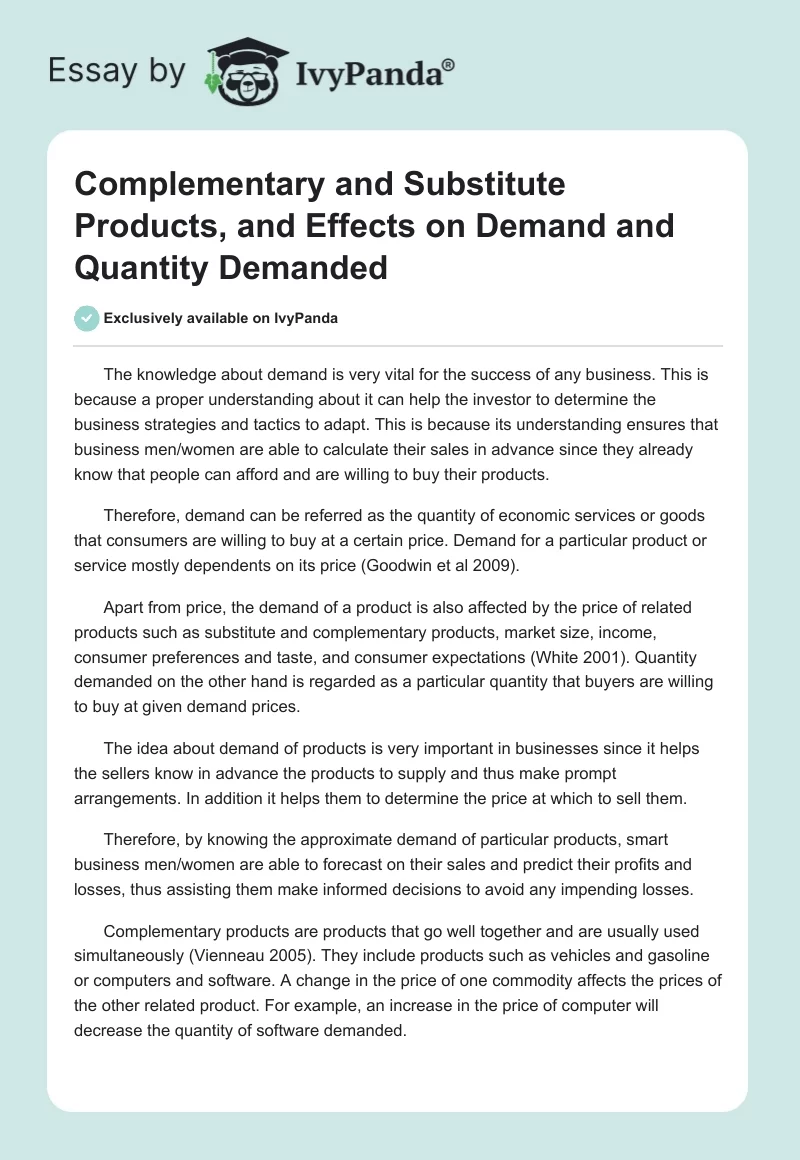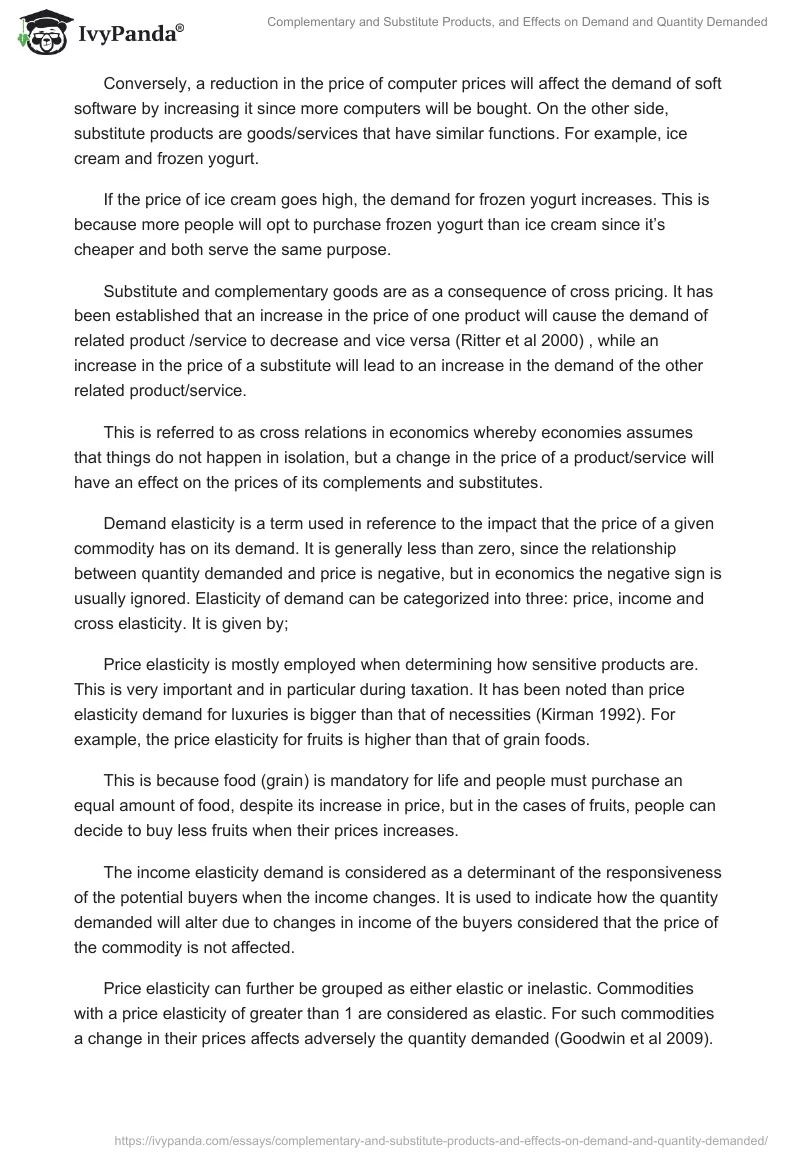The knowledge about demand is very vital for the success of any business. This is because a proper understanding about it can help the investor to determine the business strategies and tactics to adapt. This is because its understanding ensures that business men/women are able to calculate their sales in advance since they already know that people can afford and are willing to buy their products.
Therefore, demand can be referred as the quantity of economic services or goods that consumers are willing to buy at a certain price. Demand for a particular product or service mostly dependents on its price (Goodwin et al 2009).
Apart from price, the demand of a product is also affected by the price of related products such as substitute and complementary products, market size, income, consumer preferences and taste, and consumer expectations (White 2001). Quantity demanded on the other hand is regarded as a particular quantity that buyers are willing to buy at given demand prices.
The idea about demand of products is very important in businesses since it helps the sellers know in advance the products to supply and thus make prompt arrangements. In addition it helps them to determine the price at which to sell them.
Therefore, by knowing the approximate demand of particular products, smart business men/women are able to forecast on their sales and predict their profits and losses, thus assisting them make informed decisions to avoid any impending losses.
Complementary products are products that go well together and are usually used simultaneously (Vienneau 2005). They include products such as vehicles and gasoline or computers and software. A change in the price of one commodity affects the prices of the other related product. For example, an increase in the price of computer will decrease the quantity of software demanded.
Conversely, a reduction in the price of computer prices will affect the demand of soft software by increasing it since more computers will be bought. On the other side, substitute products are goods/services that have similar functions. For example, ice cream and frozen yogurt.
If the price of ice cream goes high, the demand for frozen yogurt increases. This is because more people will opt to purchase frozen yogurt than ice cream since it’s cheaper and both serve the same purpose.
Substitute and complementary goods are as a consequence of cross pricing. It has been established that an increase in the price of one product will cause the demand of related product /service to decrease and vice versa (Ritter et al 2000) , while an increase in the price of a substitute will lead to an increase in the demand of the other related product/service.
This is referred to as cross relations in economics whereby economies assumes that things do not happen in isolation, but a change in the price of a product/service will have an effect on the prices of its complements and substitutes.
Demand elasticity is a term used in reference to the impact that the price of a given commodity has on its demand. It is generally less than zero, since the relationship between quantity demanded and price is negative, but in economics the negative sign is usually ignored. Elasticity of demand can be categorized into three: price, income and cross elasticity. It is given by;
Price elasticity is mostly employed when determining how sensitive products are. This is very important and in particular during taxation. It has been noted than price elasticity demand for luxuries is bigger than that of necessities (Kirman 1992). For example, the price elasticity for fruits is higher than that of grain foods.
This is because food (grain) is mandatory for life and people must purchase an equal amount of food, despite its increase in price, but in the cases of fruits, people can decide to buy less fruits when their prices increases.
The income elasticity demand is considered as a determinant of the responsiveness of the potential buyers when the income changes. It is used to indicate how the quantity demanded will alter due to changes in income of the buyers considered that the price of the commodity is not affected.
Price elasticity can further be grouped as either elastic or inelastic. Commodities with a price elasticity of greater than 1 are considered as elastic. For such commodities a change in their prices affects adversely the quantity demanded (Goodwin et al 2009).
Products that have a perfectly elastic demand have their demand curve horizontal. It has been established that products that posses a high elasticity of demand are affected negatively when their prices increases, since there is a reduction in the number of products sold thus, reducing the overall revenue generated.
This is because the revenue received from the price increase is much lesser than the revenue lost due to the loss in quantity sold. An example of a commodity with such elasticity is a washing machine.
Commodities with price elasticity of less than 1 are considered inelastic. In such commodities a price change does not affect the quantity demanded greatly. Products that are perfect inelastic have their demand curve vertical (Vienneau 2005).
The changes in the price of products often characterized by inelastic demand usually leads to increased revenue because the apparent loss in revenue as a result of the slight reduction in sales following the price increase of a commodity is still less that the corresponding revenue gain as a result of price increase. An example of a product with inelastic price elasticity is salt.
When the price elasticity is 1 it is referred as unitary price elasticity and it results from small changes in prices that do not affect the revenue generated.
Income elasticity = Proportionate change in quantity purchased
Proportionate change in income
In most cases people will tend to purchase more when their income increases unless when the products they were buying happens to be of inferior quality.
Zero income elasticity is often attained if the quantity of a product demanded is not changed by a resultant income increase. This occurs only when the demanded product is of inferior quality. In such cases people tend to shift their taste to purchase other similar products which are considered to be of better quality.
Price and income elasticity are very effective instruments to determine the sensitivity of various products and often used as taxation incidences.
In cross elasticity the change in the demand of one good/service alters the demand of the other. Such a scenario usually takes place in substitute and complementary goods when there is a rise in the demand for complementary products, thereby also pushing the increase in demand for other products as well.
On the other hand, in as far as substitute products are concerned, when we have a rise in the demand of one commodity, there is a corresponding reduction in the demand of another commodity.
Cross elasticity is =proportionate change in demand of commodity x
Proportionate change in demand of commodity y
In summary, the elasticity of demand for a single demand curve is subject to the following factors:
- Existence of substitutes: The elasticity increases with an increase in the number of substitutes. That is why gasoline is very expensive because of lack of many substitutes.
- Extent of necessities: a higher elasticity is often manifested by luxuries, in comparison with necessities
- Price of items: expensive products tend to have higher elasticity than less expensive products. Salt is generally cheap to many families across the globe. It usually takes very little percentage of the family budget and therefore an increase in its price will not cause considerable change, whereas a change in price of a washing machine which is comparatively an expensive commodity to many households will greatly affect its sale.
- Time span: Elasticity is noted to be greater over a long time frame since people take time to adjust. For instance, over a short-run, people may cope with the high prices of gasoline, but if its increase in price persists people will develop alternative sources of energy which will act as a substitute in the long-run.
- Temporal or permanent changes: a one day reduction in price will have a greater impact than an equal permanent reduction.
- Price points: A decrease from $ 5.00 t0 $ 4.99 with have a bigger impact than a similar decrease from $ 4.99 t0- $ 4.98.
Reference List
Goodwin, N., Nelson, J., Ackerman, F., & Weissskopf, T., 2009, Microeconomics in Context. (2nd Ed.). New York: Sharpe
Kirman, A. P., 1992. Whom or What Does the Representative Individual Represent? Journal of Economic Perspectives, Vol. 6, No. 2, pp. 117-136
Ritter, L., Silber, William., Udell, G., 2000. Principles of Money, Banking, and Financial Markets (10th ed.). Menlo Park, C.: Addison-Wesley
Vienneau, R. L., 2005. On Labour Demand and Equilibria of the Firm. Manchester School, Vol. 73, No. 5, pp. 612-619
White, G., 2001. The Poverty of Conventional Economic Wisdom and the Search for Alternative Economic and Social Policies. The Drawing Board: An Australian Review of Public Affairs, Vol. 2, No. 2, pp. 67-87


